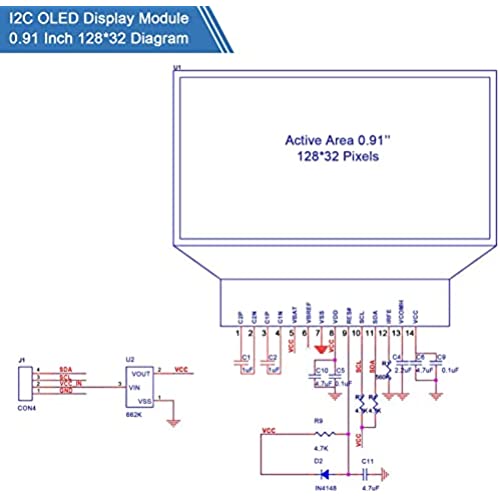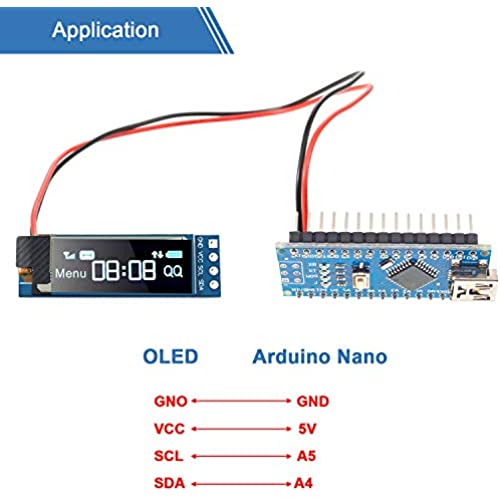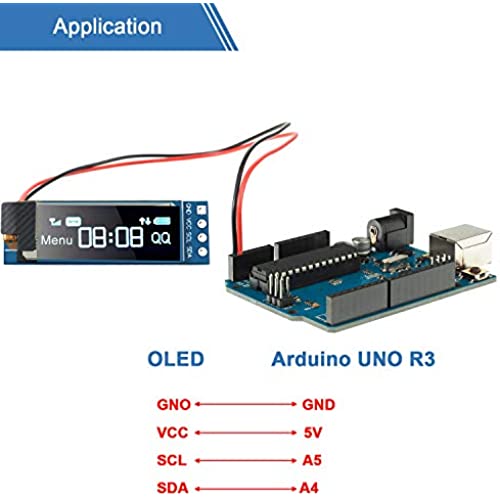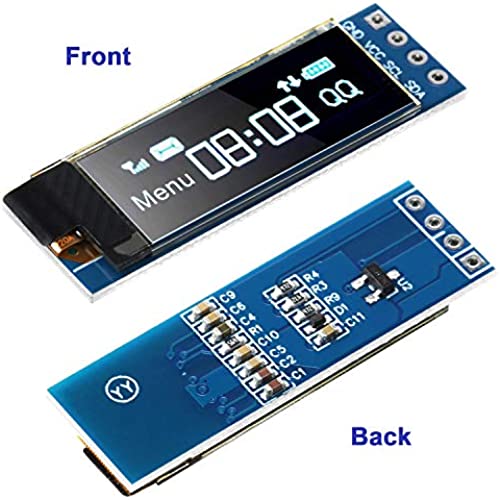

















5 Pieces I2C Display Module 0.91 Inch I2C OLED Display Module Blue I2C OLED Screen Driver DC 3.3V~5V(Blue Display Color)
-

Ryan Peters
> 24 hourA bit smaller than I expected, but they are great little screens. Easy to read, and easy to use. Works perfect for displaying a little bar graph and some data.
-

Gregory A. Mccoy
> 24 hourThese are great value. Just be aware they are very small. Until you get one in your hand, its hard to convey how diminutive they are. Fortunately, they are very crisp and bright
-

Robin yuen
> 24 hourWas a little nervous buying them reference the price, but took a chance. The silk screening was very nice. Nice bright blue for the board, and bright white for the lettering. Each OLED came with a header. They fit very tightly. Once I connected the headers with the board with out soldering, I was able to hold the board upside down by the headers and they did not come off. (still kind of new to this, so dont judge me), soldered at 433 soldered perfectly. No burning, warping, or discoloration on the board, the heasers did not melt (make sure you use flux, makes a world of difference. Nice bright images even in full light. Was kinda mad when I first saw the screens, they looked all messed up, but saw that there are screen protectors on them. Nice little touch for a cheep priced screen. Ill buy more just to have some laying around. I got them up and running 09/29/2021. Now lets see how long they last.
-

Barbaraa
> 24 hourThis is an awesome, tiny, high resolution OLED for any of your micro controller projects. It used the very common I2C bus, and runs on the SSD1306 display driver. 128x32 pixels gives you a nice sharp, crisp text output. Im very happy with these. This is a really good way to add a very compact LCD to your project. No need to add some big bulky backlit LED, go with this instead! I used the Adafruit SSD 1306 Libraries and they worked great. They are low power and bright. For the adafruit library examples, they really are over the top. There is no hello world essentially, so just do a google search for a hello world example for the libraries to get a basic starting point. Also, to rotate the display 180 Degrees, put in display. setRotation(2); in the setup. Basic usage for those libraries are.. display. display() ; display. clearDisplay() ; display. setTexSize(1-3) ; display. setCursor(0,0) ; // origin of text display. print(blah) display.println(-appended to last word blah, then new line ) ; As for the hardware, the displays are nice and small. If you think of your breadboard, they are 4 rows high, then about 12 slots wide. (Thats the entire board.) Voltage range is impressive and seems to operate at lower than 3.3, but Im running it on 4.5V and there are no problems. (Basically, 5v from the wall but through a diode on the arduino). It takes around 5ma. With a watch dog timer and adjustment I bet you could I get a whole pro mini project to run at under 3ma standby while keeping the display going. Refresh time on the display is very fast and cameras dont pick up any multiplexing/flicker. They did not come with headers, but the plated through holes are very well done and take solder well. The holes are pretty snug, which means its strong. It will be hard to desolder these after , so google some tricks on removing header pins to make your life easier!
-

P. Wilson
> 24 hourI think these will work well, but Ive not seen any info telling me what the I2C address is for the module... any information anyone can share ?
-

Speedy Blue
> 24 hourBright. All worked out of the box. ssd1306
-

Robin Morrison
> 24 hourExcellent product
-

Jhon Fredy Rios
> 24 hourConcuerda con la descripcion, funcionan perfectamente.
-

Johnnie N.
> 24 hourAfter some experimenting I came up with the following to use this with the Seeeduino XIAO in PlatformIO. Display GND --> XIAO GND Display VCC --> XIAO 3V3 (not 5V!) Display SDA --> XIAO SDA Display SCL --> XIAO SCL library used: lib_deps = olikraus/U8g2@^2.28.8 example main.cpp with some comments added: #include <Arduino.h> #include <U8x8lib.h> U8X8_SSD1306_128X32_UNIVISION_HW_I2C u8x8(/* reset=*/ U8X8_PIN_NONE); void setup(void) { u8x8.begin(); u8x8.setFlipMode(1); // set number from 1 to 3, the screen word will rotary 180 } void loop(void) { u8x8.setFont(u8x8_font_chroma48medium8_r); u8x8.setCursor(0, 0); // char row, col - not pixel u8x8.println(===============); // if string too long it wraps and flickers u8x8.println( Hello,); // println() advances to next row u8x8.println( World!); u8x8.println( ===============); u8x8.println( test test test=); // <- this will not be shown on the 4 line screen } Since all I am looking for in this display is a simple character output this library will work fine for me. I tried the Adafruit and the SeeedStudio OLED libraries and I assume I never got the device type correct for a few frustrating hours of trial and error and error. I was also able to get the graphics library to work on this using the following constructor: #include <U8g2lib.h> U8G2_SSD1306_128X32_UNIVISION_F_HW_I2C u8g2(U8G2_R0, U8X8_PIN_NONE);
-

Irina V.
> 24 hourThe screen is evenly aligned, well glued. This item looks better than I was purchasing from other vendors before.






